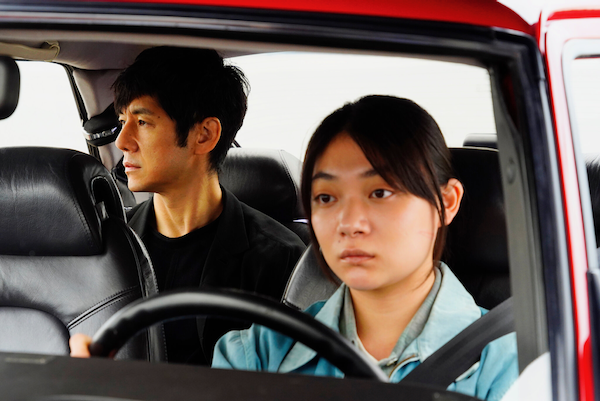Movie review by Greg Carlson
The first Japanese winners of the Best Screenplay Award at the Cannes Film Festival, Ryusuke Hamaguchi and Takamasa Oe expand “Drive My Car,” the short story of the same name in Haruki Murakami’s 2014 collection “Men Without Women,” to great success. And although the film lost the Palme d’Or to Julia Ducournau’s “Titane,” director Hamaguchi’s heavy-duty drama has emerged as one of 2021’s most admired features, collecting a sizable number of award season accolades. At 179 minutes, the running time of “Drive My Car” contrasts sharply with the brevity of Jun Ichikawa’s “Tony Takitani,” the 2004 adaptation of another Murakami story that deals with similar themes and shares a major plot point.
A three-hour investment for an introspective movie about a grieving theatre director staging a multilingual production of “Uncle Vanya” sounds difficult to sell to mainstream audiences, but Hamaguchi’s expansiveness is an asset. The filmmaker’s reputation for sprawl has been partly exaggerated: “Asako I & II” and “Wheel of Fortune and Fantasy” both clock in at two hours apiece. It is 2015’s “Happy Hour,” at 317 minutes, that stretches the bathroom-break limit. “Drive My Car” is fleeting by comparison. For all the viewers who give themselves over to the filmmaker’s meticulous attention to detail and powerful expression of character, the entire movie flies.
Hamaguchi’s set-up/prologue unfolds like a self-contained feature bursting with possibilities (the opening titles don’t arrive until the forty-minute mark). Hidetoshi Nishijima’s Yūsuke Kafuku is a Tokyo-based theatre artist married to a busy screenwriter named Oto (Reika Kirishima). Their collaborative compatibility crackles with an erotic electricity – Oto’s script ideas are devised during the verbal exchanges shared during sex. Hamaguchi carefully seeds surprises that will be revisited much later. Even greater realizations will be made. Many of these will involve troubled young actor Takatsuki (Masaki Okada), one of the film’s several endlessly fascinating secondary characters.
Two years following the opening section, Kafuku travels to his residency at the Hiroshima Art and Culture Theater in his vivid red Saab 900 (changed from Murakami’s yellow). While behind the wheel, he listens to the recording of Oto reading “Uncle Vanya” dialogue with gaps where Vanya’s lines go; it’s Kafuku’s preferred method for memorization. But following his arrival, there’s a wrinkle. For insurance purposes, his hosts require a professional chauffeur – no exceptions. Following a tryout, Kafuku agrees to the rule. His driver is a young woman named Misaki Watari (Tōko Miura).
As Misaki and Kafuku get to know one another, the unconventional stage interpretation of “Uncle Vanya” weaves throughout the developing action in a kind of parallel story-within-the-story. It’s a tried and true technique that has been used, in one variation or another, for decades: Carne’s “Les Enfants du Paradis,” Ozu’s “Floating Weeds,” Hamaguchi favorite Cassavetes’s “Opening Night,” and of course Malle’s “Vanya on 42nd Street.” Away from the stage, however, the interior of Kafuku’s vehicle plays host to different kinds of drama.
They are surrounded by an incredible ensemble of characters with the capacity to astonish, but the relationship that develops between Kafuku and Misaki fuels Hamaguchi’s examination of how people choose to process long-internalized feelings of guilt and pain. Neither one of these two essential figures is inclined toward verbal expression, but each will divulge information and make striking confessions in moments of earth-shaking emotional energy that expose raw vulnerabilities we’re hardly prepared to witness.
